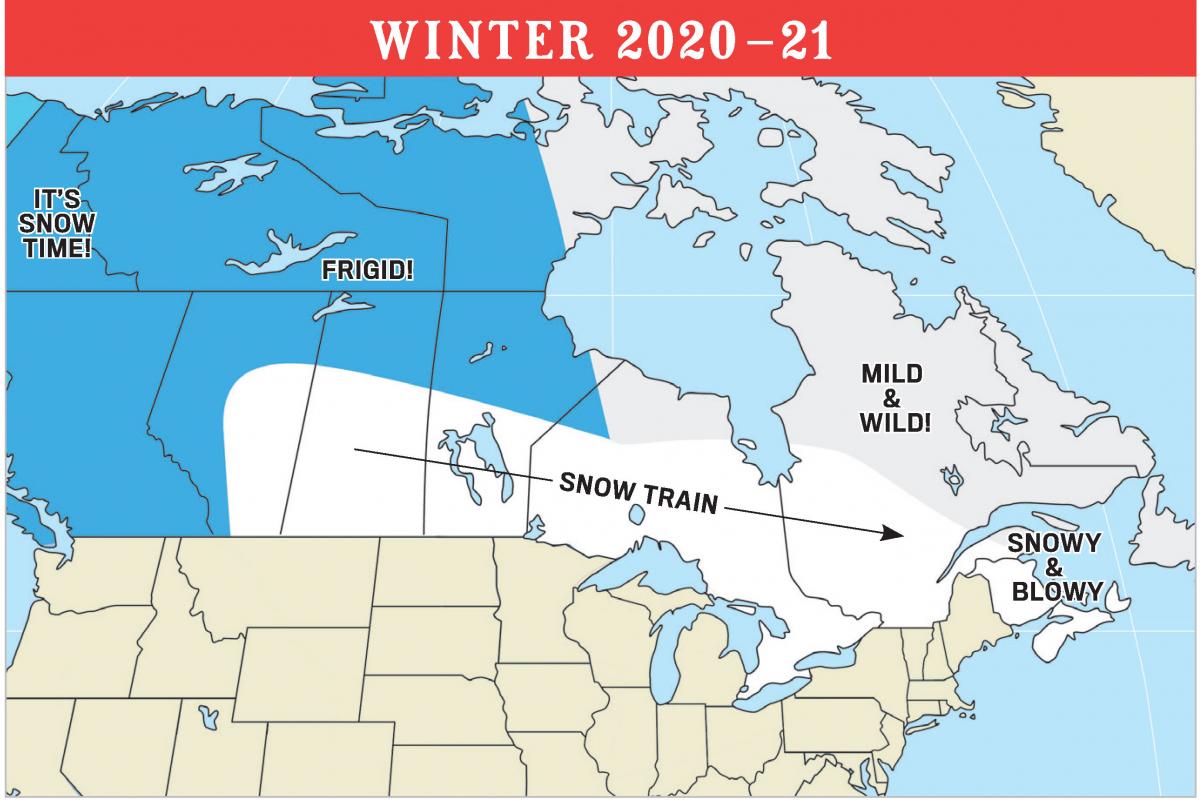The Old Farmer’s Almanac has published its 2020 – 2021 winter weather forecast, prediction outlook. The long-running forecasts are reportedly about 80% accurate.
The 2020 – 2021 Winter Weather Forecast
Here is more from The Old Farmer’s Almanac
We’ve been revealing the different regions for this past week and today—with the official release of The 2021 Old Farmer’s Almanac edition—we can completely unveil our winter maps for all of the U.S. and Canada.
Good maps, certainly, but not our complete forecast. For that, you’ll need a copy of The 2021 Old Farmer’s Almanac, which can now be found in local stores across North America. Or, order a copy from the comfort of your easy chair at TheAlmanacStore.com.
Will it be a snowy winter? Will it be an exceptionally cold winter? How bad a winter is it going to be? Without further ado, let’s start highlighting what kind of winter we’re going to have in the 2020-2021 season—and why.
WHAT’S SHAPING THE WEATHER?
We are currently transitioning from Solar Cycle 24 to Solar Cycle 25. Cycle 24 was the smallest in more than 100 years and possibly the smallest since the Dalton Minimum in the early 1800s, while Cycle 25 is expected to also bring very low solar activity.
Although low levels of solar activity have historically been associated with cooler temperatures, on average, across Earth, we believe that rising temperature trends mean that the winter will not be extremely cold.
For the United States, we predict that recent warming trends will dominate in the eastern and northern parts of the United States in the coming winter, with below-normal average temperatures limited to the western portion of the nation. Most of Canada will have a cold and snowy winter. However, rising temperature trends mean that the winter will not bring extreme cold; instead, it will be closer to normal.
U.S. WINTER WEATHER FORECAST 2020-2021
If you were hoping for a reprieve from harsh winter weather this year, we have some news that just might make you smile. We’re predicting a light winter for most of us here in the United States, with warmer-than-normal temperatures in the forecast for a large part of the country.
Uncommonly chilly temperatures will be limited mostly to the western states and northeastern New England. Specifically, winter will be colder than normal in Maine; the Intermountain, Desert Southwest, and Pacific Southwest regions; and eastern Hawaii and above normal elsewhere.
On the precipitation side of things, expect “wet” to be a wintertime constant, with rain or average to below-average snowfall to be the standard throughout most of the country.
Specifically, precipitation will be below normal from Delmarva into North Carolina; in the southern Appalachians, Georgia, and Florida from the Ohio Valley westward to the Pacific and southward to the Gulf and Mexico; and in western Hawaii and above or near normal elsewhere.
Snowfall will be greater than normal in the Northeast, Wisconsin, Upper Michigan, the High Plains, and northern Alaska and below normal in most other areas that receive snow.
Order Your U.S. 2021 Almanac Here
CANADIAN WINTER WEATHER FORECAST 2020-2021
The 2021 Old Farmer’s Almanac Canadian Edition is calling for below-normal winter temperatures through most of the country. However, it’s still winter and expect frigid and frosty weather!
The exception will be in Atlantic Canada and the Prairies, which will experience above-normal temperatures.
Precipitation will be above normal in all of the Commonwealth. Snowfall will be much greater than normal from Quebec westward through most of the Prairies and close to normal elsewhere.
So, while the Atlantic Canada and the Prairies may feel some relief from winter’s chill, they–like the rest of the country—will see lots of rain, snow, and sleet.
Areas from Alberta eastward to Quebec should brace for a virtually continual “Snow Train” that will be carrying a series of winter storms throughout the season.




